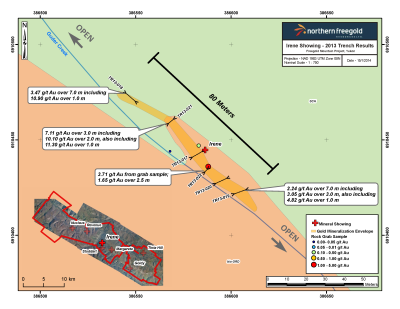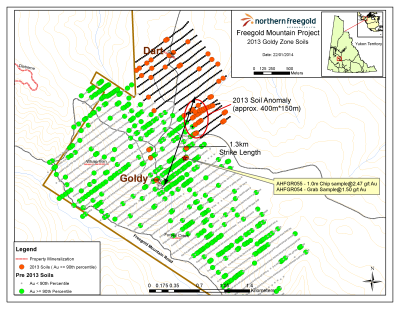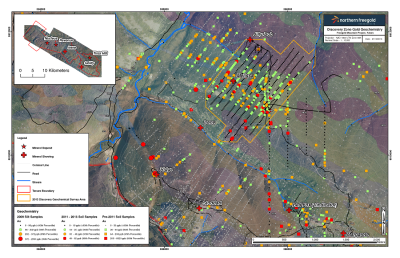Vancouver, BC / February 27, 2014 /
ACCESSWIRE / Northern Freegold Resources Ltd. (NFR: TSX-V,
NFRGF: OTCQX) is pleased to announce that it has
received the final report on the results of the 2013 exploration
program at the Freegold Mountain Project ("Freegold" or the
"Property"). The project is 100% owned by Northern Freegold (the
"Company") and is road accessible, located 70 km west of Carmacks
in the Dawson gold belt of southwestern Yukon.
The 2013
exploration program was designed to evaluate select areas of the
property east of the Nucleus and Revenue deposits which have
previously shown significant potential to host high grade
epithermal and skarn hosted gold mineralization, but have received
only limited exploration in recent years. More specifically the
company focused on three key areas of interest which have
historically been referred to as follows: Seymour, Discovery, and
Goldy-Dart.
The program
consisted of historic data compilation, soil geochemical surveys,
trenching, bedrock mapping, petrographic analysis and geochemical
data analysis. Fieldwork took place between August 10th, 2013 and
September 26th, 2013. During this time a total of 1176 soil
samples, 207 rock chip samples, 28 rock grab samples, 15 C-horizon
soil samples, and 5 stream sediment samples were collected for
geochemical analysis.
Highlights of the 2013 Exploration Program:
-New Irene
discovery shows potential for high-grade gold mineralization at
surface
-Assay values up
to7.11 gpt Au over 3.0 metres including 11.35 gpt Au over 1.0
metres
-2013 sampling
confirmed gold mineralization over an area measuring 6.5 metres
true width by 80 metres along strike
-The zone remains
open in all directions
-Close proximity
to Stoddart porphyry and Revenue deposit
-Significant gold
recovered from placer mining operations located near Irene
showing
-Drill target
identified
-Expansion of two
significant geochemical anomalies at the Discovery and Goldy
zones
-No assessment
commitments until 2023 once the assessment credit for the 2013
exploration work is applied
The work program
was successful in locating a significant new mineral occurrence
named the "Irene". Located 1.2 kilometres north of the Stoddart
prospect and 4.6 kilometres east of the Revenue Deposit, the Irene
occurrence is comprised of structurally controlled epithermal gold
mineralization. Bedrock sampling confirmed gold mineralization over
an area measuring 6.5 metres true width by 80.0 metres along strike
with gold assays from trench TR13-021 returning 7.11 gpt Au over
3.0 metres including 11.35 gpt Au over 1.0 metre. The zone remains
open in all directions with bedrock exposure in the immediate area
encumbered by extensive gravel cover.
The program was
also successful in re-defining and expanding two significant
multi-element geochemical anomalies which warrant follow up work.
One anomaly is centred on the historic Melissa showing on the
western flank of Freegold Mountain whilst the other anomaly is
located north of the Goldy showing on the eastern flank of Freegold
Mountain.
John Burges,
President and CEO said "We are pleased with the results from the
exploration program. The focus on higher gold grade potential paid
off with the new discovery at Irene. Irene is strategically located
along a major structure, close to known porphyries, and appears to
have size potential. Such a new discovery highlights the potential
for high-grade gold mineralization near surface, in an
under-explored area of the Property and warrants follow up work
this year. Exploration work at the Discovery and Goldy
zones was successful in significantly increasing the size of the
known soil geochemical anomalies."
Irene Showing
Upon receiving
word from local placer miners that bedrock was exposed at the base
of their active workings, field geologists prospected the area and
discovered the Irene Showing in August 2013. A total of 34 chip
samples and four grab samples were collected from six trenches (see
news release 13-12 dated November 6, 2013). The sampling program at
the Irene showing returned significant Au results with assay values
up to 11.35 gpt Au over 1.0 metres. Refer to the table below for a
detailed summary of trench results. All six bedrock trenches
returned significant Au results and define a mineralized zone
currently measuring 6.5 meters wide by 80.0 meters long. The zone
remains open in all directions and represents a high-priority
exploration target.
Irene Trench Result
Highlights:
--------------------------------------------------------------------------
|Trench |UTM |UTM |Mineralized Intervals |
|Name |E* |N* | |
|------------------------------------------------------------------------|
|TR13-017|386583|6910441|0.93 gpt Au/6.5 m (including 3.57 gpt Au/1.5 m) |
|------------------------------------------------------------------------|
|TR13-018|386550|6910470|3.47 gpt Au/7.0 m (including 10.90 gpt Au/1.0 m)|
|------------------------------------------------------------------------|
|TR13-019|386608|6910424|2.24 gpt Au/7.0 m (including 3.05 gpt |
| | | |Au/3.0 m; also including 4.82 gpt Au/1.0 |
| | | |m) |
|------------------------------------------------------------------------|
|TR13-020|386598|6910430|0.48 gpt Au/7.0 m (including 1.49 gpt Au/2.0 m) |
|------------------------------------------------------------------------|
|TR13-021|386570|6910461|7.11 gpt Au/3.0 m (including 10.1 gpt |
| | | |Au/2.0 m; also including 11.3 gpt Au/1.0 |
| | | |m) |
|------------------------------------------------------------------------|
|TR13-022|386588|6910435|1.65 gpt Au/2.5 m |
--------------------------------------------------------------------------
*NAD 83, Zone 8N
Historic work in
the area includes a 353 sample soil survey (50 m stations on lines
100 m apart) within the Guder Creek drainage basin completed by
Noranda in 1986 which has identified several areas of coincident
>90th percentile Au and As values. Boulders of magnetite
carrying native gold were found in the creek during the 1986
program and returned assays up to 170.00 gpt Au. Noranda conducted
242 line metres of mechanized trenching from six trenches during
1987 in the Guder Gulch area. The program was hindered by
permafrost which limited bedrock exposure, however an assay of 2.14
gpt Au with 324 ppm As was returned from a bedrock sample in Trench
TGC-87-02 located approximately 500 metres northwest of the Irene
showing.

Click Image To View Full Size
The local geology
is characterized by variably altered light grey to white
metasedimentary rock, buff white to grey quartz-feldspar porphyry
and dark to light grey, medium grained biotite granodiorite. Both
the metasedimentary unit and the biotite granodiorite display
moderate to intense sericitic (quartz-sericite-pyrite) alteration
and intense phyllic (clay) alteration. Intense chalcedonic
quartz-pyrite replacement is directly related to brecciation/vein
development and mineralization associated with brittle deformation.
Clay alteration is pervasive within brittle shear zones and
selectively replaces feldspar within the biotite granodiorite.
Mineralization is contained within veins, veinlets, breccias and
gouge which have preferentially exploited the faulted contact zone
between the two rock units. Gold mineralization is intimately
associated with arsenopyrite, stibnite and to a lesser degree
pyrite and is hosted within a chalcedonic quartz-dolomite +/-
calcite gangue. Arsenopyrite and stibnite were observed as very
fine-coarse grained euhedral disseminations (<1%) within the
breccia matrix and fault gouge, and as semi-massive fracture fill
within veins/veinlets.
The Irene showing
is located within a prominent northwest trending structural feature
which forms the steeply incised Guder Gulch, and is interpreted to
be a splay of the Big Creek Fault Zone. Veining and mineralization
parallel Guder Gulch and the contact between the two rock units
with an average strike of 315? and dip moderately to steeply
northeast. Brittle shear zones containing disseminated
mineralization and abundant clay gouge also parallel the
vein/breccia systems and the fault contact between the two rock
units. Post-mineralization brittle fault zones oriented 020 - 030 ?
and dipping moderately to steeply to the east-southeast, displaying
an unknown amount of left-lateral displacement, offset the
mineralized zone. These late brittle faults are readily observed on
the property orthophoto as a series of prominent north-northeast
and north-northwest trending recessive lineaments, north and south
of Guder creek respectively.
Examination of
the gold nuggets recovered from Guder Creek by local placer miners
indicated three distinct sources:
-
1.native gold occurring with magnetite in
nuggets;
-
2.native gold occurring in quartz with nuggets;
and
-
3.fine
gold associated with bismuth and arsenopyrite-stibnite alloys.
Native bismuth,
bismuth alloys, magnetite and scheelite were also recovered from
the placer operation. The significant amount of gold recovered by
the placer miners from a relatively small sample area, the variety
of gold and the presence of favorable pathfinder elements such as
bismuth, arsenopyrite and tungsten suggest that the Guder Gulch
area was a fertile corridor for gold mineralization. Future
exploration in the immediate area should include: compilation and
evaluation of all historic data, remodeling of existing geophysical
data (Mag, IP and VLF-EM) using petrophysical constraints,
geochemical orientation surveys to determine the best method for
seeing through extensive till cover, mechanized and conventional
auger geochemical sampling, bedrock trenching, and diamond
drilling.
Goldy Zone
The objectives of
the 2013 program at the Goldy Zone were to conduct orientation
surveys over zones of known mineralization and to extend the
soil geochemical survey north of the historic grid, completed
in 1987. Orientation surveys were
completed over zones of interest identified through historic
trenching and geochemical soil surveys. Exploratory pits were dug
using an excavator to a depth where samples could be collected from
the B-Horizon/C-horizon interface. Rock samples were also collected
where possible to provide analytical results which characterize the
lithogeochemical signature of the mineralization. Comparison of the
data indicates that soils overlying zones of mineralization are
enriched in gold and the key pathfinder elements arsenic and
cadmium. B-horizon soil samples were collected using soil
augers.

Click Image To View Full Size
The Goldy
orientation survey was completed over zones of interest identified
through historic trenching and geochemical soil sampling in the
area surrounding the Goldy showing. The orientation survey was
highly successful in repeating historic results from six different
soil samples sites (AHFGD001 - 005 & MMFGD002)
with five of six samples returning > 99th
percentile gold and all samples returning > 95th
percentile gold. All sample locations remain high priority targets
for follow up work, with particular interest on samples AHFGD001
which returned 2730 ppb Au/4100 ppm As/3.07 ppm Cd, AHFGD002 which
returned 635 ppb Au/6860 ppm As/3.72 ppm Cd and MMFGD002 which
returned 218 ppb Au/230 ppm As/1.33 ppm Cd (see news release 14-02
dated January 29, 2014).
The B-horizon
geochemical survey located approximately one km north from the
Goldy Zone has successfully delineated a 150 metre wide by 400
metre long extension of coincident anomalous gold
(90th-99th
percentile) - arsenic
(90th-99th
percentile) - cadmium
(90th-95th
percentile) in soil north of the existing geochemical grid
completed in 1987. The total strike length of the anomalous zone is
currently defined 1.3 km north of the Goldy showing.
A 1.0 metre chip
sample (AHFGR055, Tr13-010) located 475 metres
north-northeast of the Goldy Zone returned an assay value of 2.47
g/t Au. The sample appears to represent a splay of the structure
which hosts the main Goldy showing. A grab sample (AHFGR054) of
silica altered fault breccia, collected 20 metres west of AHFGR055,
returned an assay value of 1.50 g/t Au. This area is
considered a high-priority target for future exploration within the
Goldy Zone, as it presents the opportunity to significantly expand
the current extent of the main showing located 450 metres to the
southwest. This interpretation is backed by both historic and 2013
geochemical results (both soil and silt). Future work is
recommended in the area to define the full extent of the gold
bearing zone and should include a detailed C-horizon or bedrock
chip sampling program to establish diamond drill
targets.
Discovery Zone

Click Image To View Full Size
The Discovery Zone survey successfully delineated a
150-300 metre wide by 900 metre long west-northwest
trending zone of coincident anomalous gold
(90th-99th
percentile) - silver
(90th-99th
percentile) - arsenic
(90th-99th
percentile) - bismuth
(75th-99th
percentile) - lead
(90th-99th
percentile) - antimony
(75th-99th
percentile) east of the existing geochemical grid completed
in 1986 and west of the geochemical grid completed in 2011. The
total strike length of the anomalous gold zone (> 90th
percentile) is currently defined up to 1.7 km. The anomaly is
interpreted to define a widespread hydrothermal alteration zone
within metasedimentary rocks and is spatially associated with
quartz-feldspar porphyry dyke swarms and west-northwest trending
structural lineaments. The anomaly encompasses the historic Melissa
and Lucinda showings. Geochemical results from rock chip
samples collected from TR13-002 indicate that both the
quartz-feldspar porphyry dykes and metasedimentary rocks have
elevated levels of arsenic and weakly anomalous gold (see news
release 14-01 dated January 20, 2014). Follow up geochemical
surveys are warranted.
QAQC
All samples were
submitted to ALS Minerals ("ALS") in Whitehorse for
prep. Geochemical analysis was completed at ALS' lab in Vancouver.
The following analytical techniques were used for all rock samples:
ME-ICP41, Au-AA23 30 g Fire Assay, and Au-GRA21 30 g Fire Assay for
all samples > 10 ppm Au. The following analytical techniques
were used for all soil and silt samples: ME-MS41, Au-TL44, and
Au-OR44 for all samples > 1 ppm Au. The Company's QAQC measures
included insertion of external blanks and standards into the sample
stream for all rock chip samples. A minimum of one standard and one
blank sample was inserted for each trench. In addition, the lab was
instructed to wet-sieve each sample prior to sample preparation in
order to minimize contamination from placer gravels.
Northern Freegold
engaged TerraLogic Exploration Inc. to oversee the 2013 exploration
program at Freegold Mountain. Project geologist, Mike
McCuaig, B.Sc. P.Geo., designed and managed the 2013 program.
TerraLogic has been operating mineral exploration projects in North
America since 2004 and has extensive experience in Yukon
Territory.
Paul Reynolds, B. Sc.
P. Geo., Vice President Exploration for Northern Freegold Resources
Ltd., is the Qualified Person, as defined by NI 43-101, for the
Freegold Mountain Project and has reviewed the technical
information in this release.
About Northern Freegold
Northern Freegold
Resources Ltd. (TSX.V: NFR; OTCQX: NFRGF) trades in Canada on the
TSX Venture Exchange under the symbol "NFR" and in the United
States on the OTCQX under the symbol "NFRGF". Northern Freegold is
a growth oriented, Canadian-based, precious metals exploration and
development company. Northern Freegold is focused on creating value
through the advancement of the district scale Freegold Mountain
project, which hosts one of the largest undeveloped gold and copper
resources in the Yukon, and the Burro Creek gold and silver
property in Arizona. For maps and more information, please visit
our website www.northernfreegold.com
On
behalf of the Board of Directors
Signed "John
Burges"
John
Burges, President and CEO
Neither the TSX Venture Exchange nor its Regulation Services
Provider (as that term is defined in policies of the TSX Venture
Exchange) accepts responsibility for the adequacy or accuracy of
this release.
Cautionary Note Regarding
Forward-Looking Statements The information in this press release includes
certain "forward-looking statements". All statements, other than
statements of historical fact, included herein including, without
limitation, plans for and intentions with respect to the company's
properties, strategic alternatives, quantity of resources or
reserves, timing of permitting, construction and production and
other milestones, are forward looking statements. Statements
concerning Mineral Reserves and Mineral Resources are also
forward-looking statements in that they reflect an assessment,
based on certain assumptions, of the mineralization that would be
encountered and mining results if the project were developed and
mined in the manner described. Forward-looking statements involve
various risks and uncertainties. There can be no assurance that
such statements will prove to be accurate, and actual results and
future events could differ materially from those anticipated in
such statements. Important factors that could cause actual results
to differ materially from NFR's expectations include the
uncertainties involving the need for additional financing to
explore and develop properties and availability of financing in the
debt and capital markets; uncertainties involved in the
interpretation of drilling
results and geological testing and the estimation of reserves and
resources; the need for cooperation of government agencies and
First Nations groups in the exploration, and development of
properties; and the need to obtain permits and governmental
approval. NFR's forward looking statements reflect the beliefs,
opinions and projections of management on the date the statements
are made. NFR assumes no obligation to update the forward looking
statements if management's beliefs, opinions, projections, or other
factors should change.
Northern Freegold Resour... (TSXV:NFR)
Historical Stock Chart
From Dec 2024 to Jan 2025

Northern Freegold Resour... (TSXV:NFR)
Historical Stock Chart
From Jan 2024 to Jan 2025
